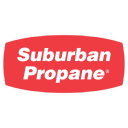A Closer Look at 2011 Distributable Cash Flow Generated by Suburban Propane Partners
This article was submitted by Ron Hiram of Wise Analysis using our Trefis Contributors tool.
Suburban Propane Partners (SPH) markets and distributes fuel oil, kerosene, diesel fuel and gasoline to approximately 48,000 residential and commercial customers in the northeast region of the United States. It is one of the largest retail marketers of propane in the United States, measured by retail gallons sold. SPH typically sells ~ 2/3 of its retail propane volume and ~ 3/4 of its retail fuel oil volume during the peak heating season of October through March.
Operating income declined 27% in fiscal 2010 (ended 9/30/10) vs. a particularly strong fiscal 2009 and declined ~6% in fiscal 2011 (ended 9/30/11). Yet SPH has maintained its distribution per unit at $3.41 ($0.8525 per quarter) for the last 7 consecutive quarters. The unit price has dropped 22% in the last 12 months (market cap is currently ~$1.56 billion) and the distribution yield is currently 7.78%. The question is whether the distribution is sustainable.
- What Should You Do With Caterpillar Stock After A Mixed Q1?
- With Product Sales Sluggish, What To Expect From Cisco’s Q3 Earnings?
- What’s Next For UPS Stock After A 6% Fall This Year?
- Rising 18% YTD, What To Expect From Amazon Stock In Q1?
- Here’s Why We Think Boeing Stock Is Undervalued At $170
- Mastercard Stock Gained 20% In The Last Six Months, What To Expect From Q1 Results?
Distributable cash flow (“DCF”) is a quantitative standard viewed by investors, analysts and the general partners of many master limited partnerships (“MLPs”) as an indicator of the MLP’s ability to generate cash flow at a level that can sustain or support an increase in quarterly distribution rates. Since DCF is not a Generally Accepted Accounting Principles (“GAAP”) measure, its definition is not standardized. In fact, as shown in a prior article, each MLP may define DCF differently. SPH does not define DCF at all and the only non-GAAP measure it reports is adjusted EBITDA. A review of its cash flows and the sustainability of its distributions can still be performed, albeit without a comparison to reported DCF.
For ease of comparison to SPH’s report on Form 10-K and to other MLPs, the table below provides numbers for both fiscal and calendar year-ends:
Data for the latest 12 months ended 12/31/11 indicates that sustainable DCF no longer covers distributions. The gap has not been filled by issuing debt or equity, but rather by reducing cash reserves. This can be seen from a simplified cash flow statement in the table below.
Compared to the prior year period, results for the first half the heating season in fiscal 2012 (i.e., quarter ended 12/31/11) show a ~8.5% drop in revenues, and a 40% drop in operating income:
Results for the second half the heating season in fiscal 2012 (i.e., quarter ended 3/31/12) will be published shortly. Based on the warmer than usual weather, they may compare unfavorably with the prior year period and that would indicate fiscal 2012 will also not look good compared to fiscal 2011.
The balance sheet indicates low leverage (long term debt to EBITDA of ~2.2x), so debt can be used to supplement additional reductions in cash reserves to maintain the current distribution level in the hope that colder weather will return in the next heating season and drive an improvement in results. But does this constitute a sound basis for an investment in SPH?



